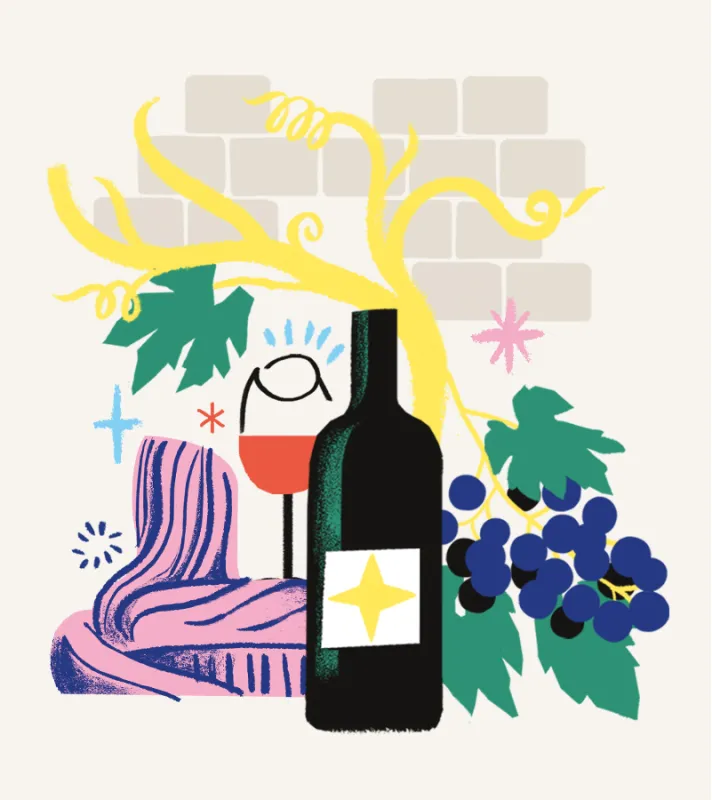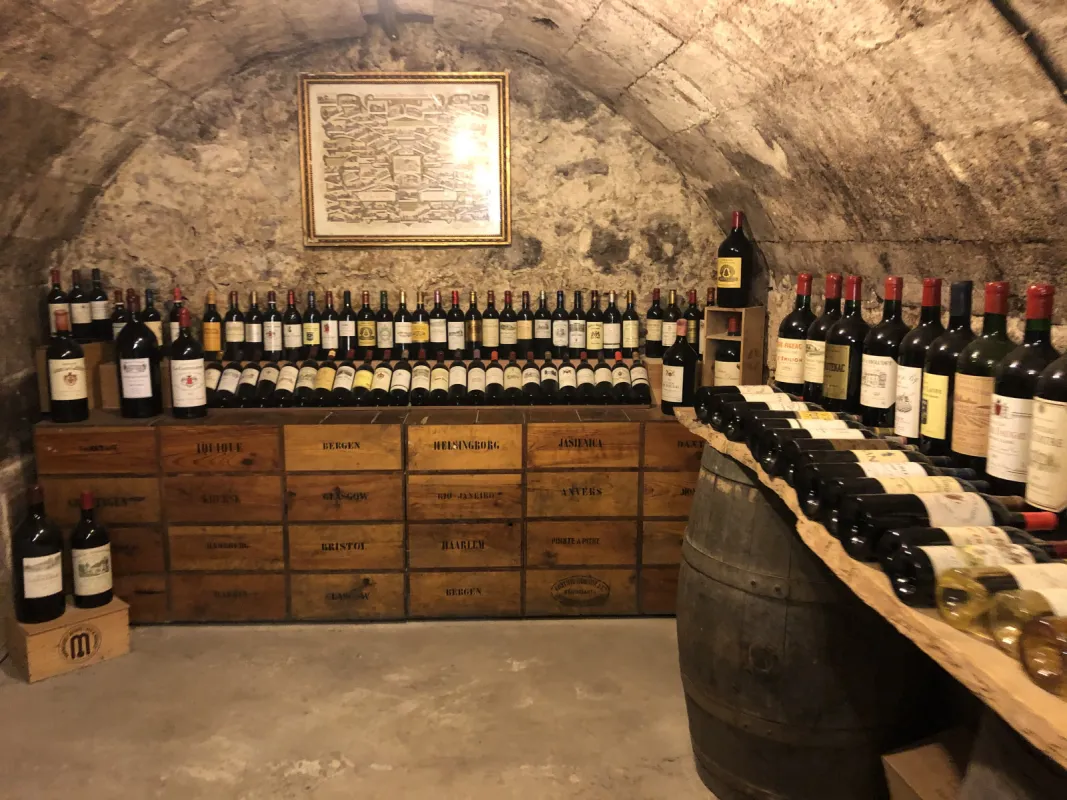
A walk exploring the traces of wine in the city
Why not set off on a hunt for traces of wine around Bordeaux?
Let's explore the city on a history, fun and flavour-filled two-hour walk (approximately). Travel across the city from the Bordeaux Wine Council (CIVB) to the Cité du Vin, finding out along the way how wine production and the wine trade have shaped the city known as ‘The Port of the Moon’ for centuries.
Sculpted details, cobbled streets, trellised vineyards... each stage of this route reveals the sometimes unsuspected winegrowing soul of the town. Winegrower? Yes, because the vines have been cultivated here and the wines have been made. So pay attention, look up and let yourself be carried away by this love story between Bordeaux and wine. And if you feel like it, take a tasting break at one of the many addresses listed on your map. Wine merchants and wine bars welcome you to share with you the history of wine today.
With your mobile phone, follow the route in real time:
- No need for a specific application
- Simply activate the geolocation via the icon on the map
Steps
The CIVB (Conseil Interprofessionnel du Vin de Bordeaux) is the headquarters for professionals working in the wine industry. Merchants and winemakers meet here to champion and promote Bordeaux wine. On the ground floor of this imposing building lies a bar where you can taste wines from all of Bordeaux’s winegrowing appellations, while admiring two splendid stained glass windows made by René Buthaud, full of wine allegories..
Here, you find yourself face to face with the city’s most remarkable statue! Take a look at the side facing the Jardin Public, where there are allusions to peace, as well as wine; even in times of war, the wine trade prospered. It is represented by the face of Bacchus and a cherub sitting upon a barrel. Can you spot them?
Though this woman is holding up a bunch of grapes towards Alexis Millardet, it isn’t to quell his hunger! She is an allegory, representing the vine thanking this scientist who, in 1885, invented the famous ‘Bordeaux mixture’. This shrewd blue copper-based mixture helped fight against mildew, a disease that attacks vines.
Before 1750, an old path running alongside Château Trompette lay here. After the fortress was destroyed, Intendant Tourny transformed the path into a beautiful tree-lined street, nicknamed ‘Le Pavé des Chartrons’. Rich merchants resided here. On the left, you can find French-style facades with balconies on squinches, plus some remarkable decorative ironwork. On the right, the Anglican church and English-style houses would hardly look out of place in some London neighbourhoods!
Entrepôt Lainé was originally built to stock goods arriving from the colonies, obtained via the triangular trade of the time like sugar, cocoa, coffee, cotton and spices. It was the work of Claude Deschamps, who was also the architect of the Pont de Pierre. Today, the building houses the CAPC, Bordeaux’s contemporary art museum, as well as the architecture centre Arc en rêve.
Here stood the first consulate ever opened by the United States. Georges Washington gave Bordeaux this honour as thanks for the part the city had played in the American War of Independence. This hôtel particulier bears the name of the first American consul, Joseph Fenwick, who ordered its construction in 1793. Two boats’ prows are featured on the facade, indicating the importance of maritime trade. If you take a few steps back, you’ll see two small square pavilions on the roof, from which you could spot boats entering the port.
This street is the spine of the vibrant Chartrons neighbourhood. In the Middle Ages it was nothing but a marshy path, but its architecture was developed to make it easier to send barrels down what become wide streets and cul-de-sacs that joined up with the wine storehouses by the Garonne. Try to imagine the sound of barrels rolling upon the cobblestones, all day long!
Merchant families from Northern Europe came to Bordeaux in droves between the 17th and 19th century. So that they might practice their religion, places of worship were built, like this Protestant temple that dates from 1832. Having been left to abandon for a few years, it has since had a second life as an exhibition space since 2019.
When nature takes root in the heart of the city, it brings freshness and poetry with it, like this grapevine espalier at number 33!
At number 65 on Rue Notre-Dame is an old lithographic print works, dating back to 1880. Here, they printed the labels for wine bottles. You’ll spot the majestic wisteria that decorates its facade and hides the traces of the old establishment’s name.
During the era of merchant shipping in the wine trade, handlers would send barrels down these small cul-de-sacs, which gave access to the quayside from the merchants’ storehouses, where they would then be loaded onto boats. The stone blocks that can be seen here and there protected the wheels of the carriages.
The merchant’s residences embellished the city with their richly decorated facades! Sculpted in the stone, you can see representations of the commercial activity that took place around Bordeaux’s port. Look up at No. 25, where you’ll see branches with grapes and cocoa beans, and don’t go past No. 21 without looking at its mascarons and ironwork.
At these former traders’ homes, there are some more beautiful, richly decorated facades, recalling the port’s activity. These houses are larger than they appear, as they’re formed of several buildings in succession. The doorway was wide to let barrels in and out. The “nobility of the cork” lived in these buildings until the 1950s.
Delve into the history of the port and the Bordeaux wine trade! Old maps, models, instruments and portraits reveal the life of the port and how it evolved, from the time when the city was a settlement named Burdigala up to today.
This museum, set up in the former home of an Irish merchant, gives us an idea of what these residences looked like. The chimney in the sitting room is still intact! Contemplate the architecture of these long, high stone buildings, with residential quarters upstairs and the storehouses, cellars and cooperages below, which are now used as an exhibition space to tell the story of wine in Bordeaux. A surprising place which is worth the detour!
In the past, the ground in this area was covered with dirt and the wine trade was in full swing. These old warehouses, side by side, have been renovated and are now a creative zone. Artists have taken up residence and, nowadays, you can find a cabinetmaker, a costume creator and a painting restorer in this resolutely artistic street.
This passage is named after the Luze family, who were Protestant merchants from Charente. It was called a courroir, playing on the French verb courir, to run, as barrels once ran down here to Garonne, some stocked on top of one another. Before joining up with the quays, stop for a moment and look at the wall on your left, where you’ll see the traces of barrels etched into the stone.
“Wine brightens the life and thinking of everyone”, said Thomas Jefferson, who helped draft the American Declaration of Independence then became president of his country from 1801 to 1809. As an ambassador, he spent a few days in Bordeaux, during which he visited several vineyards. Upon his return to the United States, this lover of wine boasted of the wonders of the Bordeaux vineyards.
Yet more beautiful facades of what were once merchants’ residences. This neoclassical style is typical of the late 19th century. Admire the balcony and its ironwork, resting on console brackets: stone structures, often in the shape of an ‘S’.
Though this place is now a walking spot for Bordeaux locals, in the past the ambiance was somewhat different! The mooring bollards are now used for cruise ships. Take a close look at the ground where the barrier blocks off the Garonne : you can still see the rails that were used by cranes when unloading goods from boats. Then, look up again and admire the row of facades merchants’ former residences.
Here sits a weaving factory, which opened in 1880. In a way, it’s a sort of haute couture workshop for bottles! Clissage is a decorative element made using raffia, linen or even stainless steel. Admire the round ironwork of the railing above the entrance.
Impasse Tramasse has kept its cobbles from the time when port workers would roll their barrels from the storehouses to the port. You can imagine the sound of them rumbling on the cobblestones…
Brokers are intermediaries between wine producers and merchants. This house belongs to the famous family of brokers, the Ripert family. Its facade is decorated by an adorable mascaron with the face of a cherub. Can you see the two little windows below? They were to aerate the cellars.
Here is a surprising example of how Bordeaux’s facades – which feature on the UNESCO World Heritage list – have been protected! In fact, at 13 Rue Bourbon, the facade is all that remains of the old merchant’s stone and brick house. It conceals a residence from the late 20th century. Take a close look at the decorative details that pay tribute to the wine trade: a vine stock is sculpted into the stone, then higher up you’ll find a barrel and a bottle rack.
It is only right that Bordeaux should have its own temple paying tribute to the historic passion that unites the city and the vine! La Cité du Vin opened in 2016. Relax in the gardens and admire the contemporary architecture, which evokes the swish of wine in a glass according to some, whereas others see the shape of a vine stock… decide for yourself. What better place to continue your odyssey in the footsteps of the wine trade in Bordeaux!
Points of Interest (POI)
14 Cour de l'Intendance
33000 Bordeaux
Tasting of Bordeaux wines by the glass
3 Rue Lafaurie Monbadon
33000 Bordeaux
Food and wine pairing guaranteed with high quality tapas
2 Allées de Tourny
33000 Bordeaux
A cellar with a spiral staircase lined with beautiful bottles
26 Allées de Tourny
33000 Bordeaux
Bordeaux wine-based chocolates
60 - 62 Allées de Tourny
33000 Bordeaux
Historic house created in 1886 which offers more than 3000 references
1-3 Cour du 30 Juillet
33000 Bordeaux
Oenology courses, tasting sessions and visits to châteaux
3 Cour du 30 Juillet
33000 Bordeaux
Wine tasting by the glass at very low prices
8 Cour du 30 Juillet
33000 Bordeaux
A Bordeaux institution offering a huge choice of Bordeaux wines
12 Cours du 30 juillet
33000 Bordeaux
Excursions to the vineyards, tastings and guided tours
2 Quai des Chartrons
33000 Bordeaux
Meal cruises, aperitifs on the water and tasting cruises
6 Rue Notre Dame
33000 Bordeaux
Purchase by the case or by the bottle, tastings
18 Rue Notre Dame
33000 Bordeaux
Wine cellar, delicatessen, tasting room and link cellar all in one
22 Quai des Chartrons
33000 Bordeaux
Private tasting courses offered by François Martin, a connoisseur of Bordeaux wines
20 Rue Minvielle
33000 Bordeaux
This wine shop also organises private tastings and receptions
105 Quai des Chartrons
33300 Bordeaux
Small artisanal pastry shop also offering a nice selection of wines
Quai de Bacalan Hangar 18
33300 Bordeaux
Gourmet grocery shop offering historical products and brands from the region
3 Rue Lucien Faure
33300 Bordeaux
Nearly 4,000 references of French and foreign wines on 120m2
134 - 150 Quai de Bacalan
33300 Bordeaux
Wine cellar, wine bar and brasserie on the ground floor of La Cité du Vin
10 Quai de Bacalan
33300 Bordeaux
Wine bar in the Halles de Bacalan
174 Rue Achard
33300 Bordeaux
Wine cellar and restaurant
31 bis Rue Barillet Deschamps
33300 Bordeaux
Wine-making cellars installed in a rehabilitated former blockhouse


























